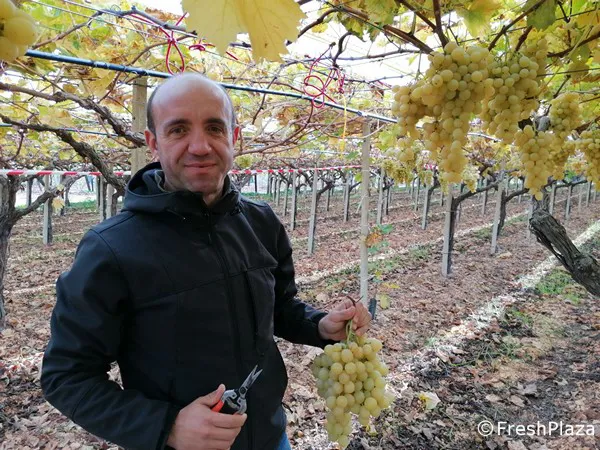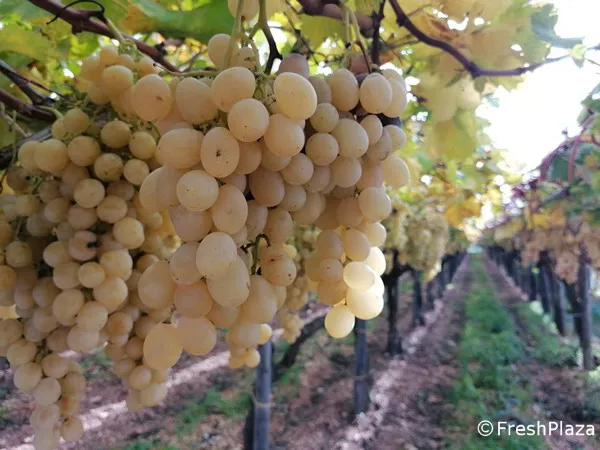The Italian grape campaign can now be considered over. In the vineyards of Apulia, the vines are empty and while there are still bunches to be seen, they are no longer marketable because they have been damaged by humidity. A number of companies ended their sales last weekend. This means that for many it is time to draw up the first balance sheets.
We interviewed Donato Fanelli, a farmer from Conversano, Bari (Italy) who has long been involved in the production and marketing of grapes.
FreshPlaza (FP): What can we say about this season? Donato Fanelli (DF): We thought we would be able to finish a few days later than last year, but instead we are forced to close the season about a month in advance. Ninety per cent of the warehouses have already finished their deliveries, while others are completing their orders as we speak. In the cells, goods have been in short supply for some time, although the situation in the field seems to suggest otherwise.
 Donato Fanelli
Donato Fanelli
FP: What role did the seedless varieties play in this campaign? DF: This season has shown that seedless varieties have overtaken traditional ones. Already in the last few years, we noticed that the consumption trend was starting to move in this direction, which attracted the attention and interest of several growers, who then decided to plant seedless varieties.
FP: Which grapes are most affected by rot? DF: "Eighty per cent of the grapes that have been left in the fields in recent weeks are traditional cultivars, especially the Italia variety, followed by Red Globe. We don't have to be fans of Greta Thunberg to understand that climate change has become a reality. What we still struggle to understand is the total lack of planning and aggregation, which makes the impact of climate change in agriculture even more dramatic. In fact, if we had cut the product by a certain date (e.g. end of October), we could have stored it in cells with innovative packaging, which would have extended the commercial calendar by around 60-70 days.
FP: Is it usual that in mid-November there was so much product left on the plants?
DF: Keeping the product on the vine for as long as possible is a practice that has always existed. The problem is how much grape was still on the vines at that time. In fact, in mid-November, we should not have had that amount of grapes left to harvest. This is not only because of the trend in consumption, which is seeing an increase in seedless varieties, but also because of us producers. Orders for grapes from Italy have fallen compared to last year, precisely because there has been an increasing decline in quality, both in terms of the yield achieved and the type of yield. This problem has emerged not only this year not enough attention was paid to seed this cultivar this year, but also because plantings are starting to become obsolete and therefore the resulting product is no longer the top quality we were used to, especially if proper agronomic practices are not applied. The average age of Italian grape plants is 15 years. The peak of quality is obtained from the first to the ninth year after entering into production.
 Italia variety grapes
Italia variety grapes
FP What could be the fastest and most effective solution? DF: We have to revive the Italian grape as the flagship of Italian production. This variety finds its perfect pedoclimatic conditions in Apulia, Sicily and Basilicata. Renovating some of the plantings could already be an easily achievable idea, as would be the idea of obtaining a certification for all products under the PGI label. The number of certified Apulia grapes is growing strongly. The numbers are increasing, both for companies that decide to cultivate according to a production regulation, so that they can then stand out on the market, and for consumers, who seem to demand a product that indicates the territory.
FP: Despite everything, are you satisfied with the 2021 season? DF: I am satisfied with the work that many farmers have carried out and with the quality that we have been able to bring to the markets, despite the weather and the not-so-satisfactory profits, due to general price increases. However, what saddens me is that, for yet another year, the aggregation that the second most exported Italian product absolutely needs to have, was instead missing. Some people believe that it was a disastrous season, but I don't think so. It seems that the emphasis on the grape sector was only focused on the first ten days of November, forgetting that in Sicily the grape harvest started in May, until Apulia too began production in early July.
